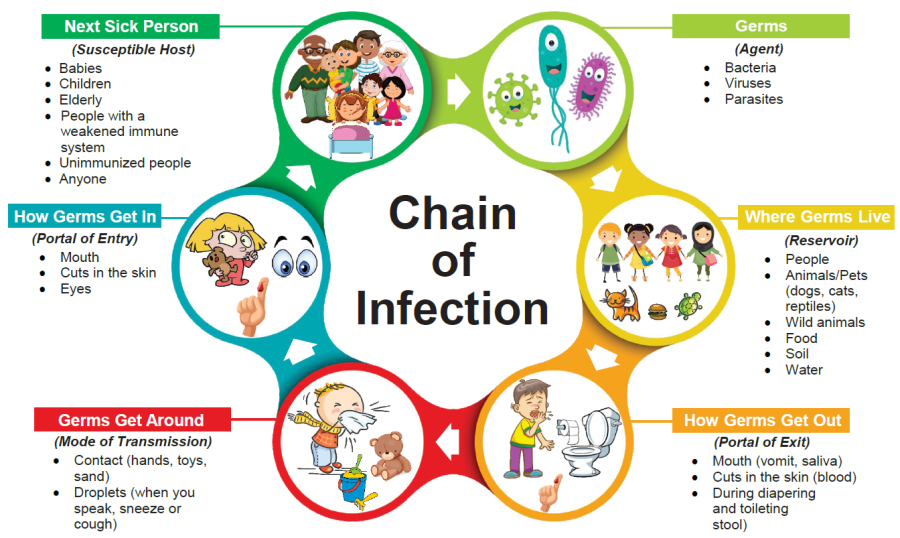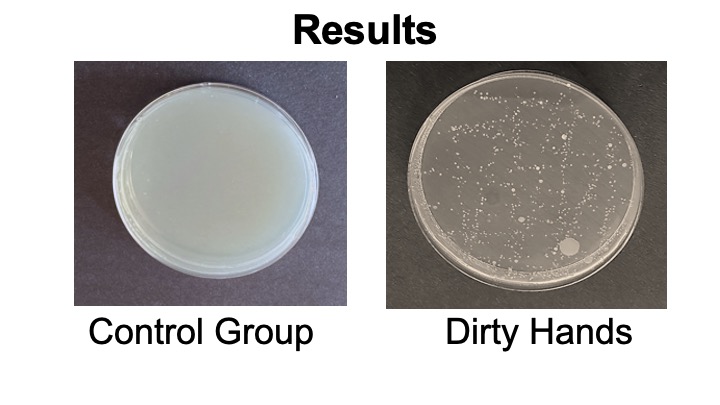Are You Eating Bacteria?
Grade 6
Presentation
Hypothesis
Only adequate hand wash time (20s) can effectively reduce bacterial transmission from hands to food.
Research
1. Bacterial infection disease
Communicable diseases have long been highlighted as global public health priority and are recognised as a leading cause of health loss globally. In 2019, Naghavi et al (3). analyzed deaths associated with 33 common bacterial pathogens across 11 major infectious syndromes by reviewing 343 million individual records from 204 countries and territories. He found 7.7 million deaths occurred as a result of bacterial infection, which involved in 13.6% of global death in 2019. Bacteria would rank as the second leading cause of death globally.
2. Chain of Infection Components
The chain of components has six sections (4,5). They include:
- Microorganisms: Disease producing, also called pathogens, including virus, parasite, fungus, bacterium
- Reservoir/Source: Environment/habitat where a pathogen can live and multiply: eg, surfaces/equipment, body fluids (blood, saliva), urine/fecal material, food/water, soil, skin, respiratory tract
- Portal of Exit: How the pathogen exits or leaves reservoir. It can happen as skin to skin, skin to surface, blood, mucous membranes, oral cavity, fecal
- Modes of Transport: How a pathogen moves from reservoir to susceptible host.
Direct Contact: including droplet (e.g., sneezing, cough), contact (e.g., skin, toy),
Indirect contact: Fomites – contaminated equipment or medication (multidose vials, single dose vials), vectors, food, water
- Portal of Entry: Opening where the pathogen may enter. Including body openings (e.g., mouth, eyes, urinary tract, respiratory tract), incisions, wounds
- Susceptible Host: The person at-risk: patient or healthcare worker. Factors affecting susceptibility (e.g., age, health, co-morbidities, immune system, nutrition, infective dose, medications)

3. Transmission of bacteria by hands
In 1855, Oliver Wendell Holmes published a book entitled Puerperal Fever, as a private Pestilence in the United States (6). In there, Holmes described a thorough investigation of women who had died of puerperal fever after one week of her post-mortem exam. He argued that the physician’s unwashed hands were responsible for the transmitting puerperal fever from patient to patient. For the first time, the role of human hands in the bacterial transmission was implicated. Subsequently, numerous studies were conducted to investigate the hand-to-hand bacterial transmission and have demonstrated that adequate hand hygiene is the best action to reduce bacterial transmission (7-9). Although washing hands for 20 s with soap is the recommended practice, studies that observed hand washing in normal practice suggest that most people wash hands for considerably less time (10). A quick wash (5s) has been commonly observed (11).
Inspired by those concepts, we want to understand the role hand in the bacterial transmission and how different hand hygiene time (5s-hand wash, 20s-hand wash) affects bacterial transmission through hands. To explore those questions, we developed a bacteria transfer model (hand-to-apple) to compare the effectiveness of hand wash regimens (5s-hand wash, 20s-hand wash) on reducing transfer bacteria to a read-to-eat apple.
4. How to study and grow bacteria at home
Agar plates, composed of growth media solidified with agar, are commonly used to culture yeast and bacteria. Cultures may be spread or streaked across the surface of these plates to facilitate titer calculations or to permit isolation of single, genetically identical colonies (12-14).
5. Statistics and Excel
Standard Deviation: A standard deviation (or σ) is a measure of how dispersed the data is in relation to the mean. Low, or small, standard deviation indicates data are clustered tightly around the mean, and high, or large, standard deviation indicates data are more spread out. A standard deviation close to zero indicates that data points are very close to the mean, whereas a larger standard deviation indicates data points are spread further away from the mean (15).
P Value: A p-value measures the probability of obtaining the observed results, assuming that the null hypothesis is true. The lower the p-value, the greater the statistical significance of the observed difference. A p-value of 0.05 or lower is generally considered statistically significant (15).
T-test: A t-test is used to determine if there is a significant difference between the means of two groups (15).
I used Excel to process my data (16)
Variables
|
Manipulated Variable |
Dependent Variable |
Controlled Variables |
|
Length of hand washing time
|
The number of bacteria colonies grown on agar plate |
|
Procedure
Materials
- Agar plate
- Dirty hand (In this experiment, the dirty hands were defined as after I shopped in 2 supermarkets for around 4hours)
- Liquid hand soap
- Sterile swab
- Timer
- Apple
- Knife
- Alcohol swab
- Electric blanket
- Kleenex
Experiment procedure:
- Prepare agar plate:
- In a 16-oz clean container, add 10 gram of agar in 750ml distilled water, stir until agar powder is dissolved
- Heated in the microwave for 7 minutes and stir intermittently
- Cool the agar mixture to 50
- Carefully pout the agar mixture into the Petri dishes until 1/3 full.
- Let the agar plate cool then place lid (to avoid the water on the )
- Keep the agar plates at 4 until use
- Wash the apple, and clean apple skin and knife with 70% isopropyl alcohol wipes to reduce potential of cross-contamination to the inside of the apple during slicing. Cut apple to slices.
- Use dirty hands to touch one apple slice for 5s
- Use a sterile cotton tip to swab the apple and transfer to Agar plate
- Wash hands with liquid soap for 5s and clean with warm tap water, dry hand with Kleenex
- Use hand with 5s-hand wash to touch an apple slice for 5s then repeat step 4
- Wash hands with liquid soap for another 15s to make a total 20s-hand wash and clean with water, dry hands with Kleenex
- Use hand with 20s-wash to touch apple slice for 5s then repeat step 4
- Use an Agar plate without any treatment as experiment control
- Plate the Agar plates up-side-down in a Zip bags and incubated with a heated blanket to keep temperature around 32-37, covered whole thing with a thick blanket
- Wait for 72 hours to let bacterial colony to grow
- Take out plate and count colonies
- Experiments will be repeated 3 times to ensure accuracy and reliability
As described in above procedure, the experiment was designed with three groups. We named three group as dirty hand, 5s-hand wash and 20s-hand wash.
A untreated agar plate will be used a control plate in each experiment to rule out contamination in experiments.
Observations
Obeservations
- Day 1: no colonies growth up in all agar plates.
- Day 2: Lots of changes starts to happen. In control plate, still no colonies growth in control, which indicated the experiment was not contaminated. A lot of tiny yellowish dots in Agar plate which was treated dirty hand. The agar plate which was treated it 5s-hands wash also grown some tiny yellowish dots. Much less bacteria dots in agar plate which was treated with 20s-hands wash.
- Day 3: All colonies grown bigger than day 2. Too many colonies in agar plate treated with dirty hands. Given the colonies might grow to connect together, and can not count colonies, I stop the incubate agar plate on day 3. (As shown in Fig 1)
Data
- Agar plates


Control group: is a untreated arga plate
- Table: Number of colonies in three repeated experiments
|
Replicate |
Dirty hand |
5s-Hand wash |
20s-Hand wash |
|
Experiment 1 |
518 |
217 |
24 |
|
Experiment 2 |
561 |
287 |
44 |
|
Experiment 3 |
466 |
399 |
55 |
|
Mean |
515 |
281 |
41 |
|
SD |
47.571 |
61.22 |
15.82 |
My quantitative data is how many bacteria colonies grow.
3. Figure: Number of bacterial colonies with different hand wash time

Analysis
Based on my experiments, we can see dirty hands transmit lots of bacterial from our hands to apple. Significantly fewer bacteria were transferred to apple from 20s-hand wash compared with dirty hand and 5s-hand wash (p <0.05). Interestingly, we found that a 5s-hand wash reduced around 50% bacterial transmission (P <0.05). Also, a 5s-hand wash yielded a bigger standard deviation than other groups. These variations might be because 5s is not enough to clean hands and contribute unstable results.
Conclusion
My experiment provided the evidence that hand is spreading bacteria in our daily life. A proper hand wash (20s) significantly reduced bacteria transmission, which is consisted with my hypothesis. Surprisingly, a quick hand wash (5s) also can reduce bacteria transmission by around 50%, and produced a statistically significant difference compared with no hand wash (dirty hands), which is opposite to my hypothesis. However, I cannot verify whether the number of bacteria left on hands from 5s-hand wash are enough to cause a disease.
Application
In this project, we visually observed the spreading of bacteria though the direct contact via hands by using hand-to-apple bacteria transfer model. If a ready-to-eat food is contaminated with bacteria from hand and then eaten, it would have potential to cause illness. Therefore, the project supports that there is a greater potential to reduce the transmission and acquisition of disease through proper hand wash. If everyone does proper hand hygiene, we are helping ourselves and others stay away from infection disease.
Sources Of Error
- The bacteria colonies growth together and make a big colony, which was counted as one colony in my study. Therefore, the counting of colony number could be a possible error.
- The experiments were repeated only for three times. More replicates can provide more accurate result
- In each experiment, I only did one agar plate for each group (dirty hand, 5s-hand wash, 20s-hand wash). If I could do more in each experiment, the data will be more reliable.
- By using different ready-to-eat food, the results might be different, e.g, dry food (bread, cookies).
- Different brand of commercial liquid soap, different water temperature and the method of drying hand could give different results.
Citations
- Seager, L.M. 2010. Good Infection Prevention: Hand Hygiene. Dent Update. 2010 Sep;37(7):478-83.
- CDC. About Handwashing. Feb 2024. https://www.cdc.gov/clean hands/about/index.html
- GBD 2019 Antimicrobial Resistance Collaborators. 2022. Global Mortality Associated With 33 Bacterial Pathogens in 2019: A Systematic Analysis For The Global Burden of Disease Study 2019. Lancet. 2022;400:2221-48
- The National Institute for Occupational Safety and Health (NIOSH). Chain of Infection Components. https://www.cdc.gov/niosh/learning/safetyculturehc/module-2/3.html
- Ottawa Public Health. Chain of Infection. https://www.ottawapublichealth.ca/en/professionals-and-partners/chain-of-infection.aspx
- Holmes OW. 1855. Puerperal Fever as a Private Pestilence. Ticknor and Fields, Boston, MA.
- Campo, R.D., Martinez-Garcia, L, Sanchez-Diza, A.M., et al. 2019. Biology of Hand-to-Hand Bacterial Transissiom. Microbiology Spectrum 7(1):MTBP-0011-2016.
- Vishwanath, R., Selvabal, A.P., Shanmugam, P. 2019. Detection of Bacterial Pathogens in the Hands of Rural School Children Across Different Age Groups and Emphasizing the Importance of Hand Wash. J PREV MED HYG 60:E103-E108.
- World Health Organization. 2019. WHO Guidelines on Hand Hygiene in Health Care: First Global Patient Safety Challenge Clean Care Is Safer Care. Transmission of pathogens by hands.
- Bischoff, W. E., T. M. Reynolds, C. N. Sessler, M. B. et al. 2000. Handwashing compliance by health care workers: the impact of introducing an accessible, alcohol-based hand antiseptic. Arch. Int. Med. 160:1017–1021
- Green, L. R., V. Radke, R. Mason, L. Bushnell, D. W. Reimann, J. C. Mack, M. D. Motsinger, T. Stigger, and C. A. Selman. 2007. Factors related to food worker hand hygiene practices. J. Food Prot. 70:661–666.
- Eyler, E., 2013. Chapter One – Pouring Agar Plates and Streaking or Spreading to Isolate Individual Colonies. Methods in enzymology. 533:3-14.
- How to Grow Bacteria in a Petri Dish. https://www.wikihow.com/Grow-Bacteria-in-a-Petri-Dish
- “How to Grow Bacteria: 5 Experiments to Grow & Test Bacteria.” Home Science Tools, 2025. https://learning-center.homesciencetools.com/article/bacteria-experiment-guide/
- National Library of Medicine. Common Terms and Equations. https://www.nlm.nih.gov/oet/ed/stats/index.html
- How to Calculate Mean, Standard Deviation (SD), Standard Error of the Mean and 95% Confidence Interval Using Excel. https://media.hhmi.org/biointeractive/vlabs/lizard2/pdfs/How_to_Calculate_Stats_in_Excel.pdf
Acknowledgement
I would like to thank my science Mr. Baillie for his teaching and guiding through every step of my science fair journey and answering my questions.
I would like to thank my family (mom, dad, sister and grandparents) for supporting me thoughout whole project.

